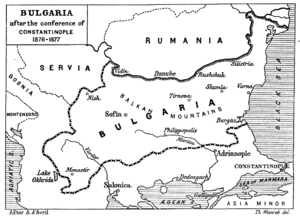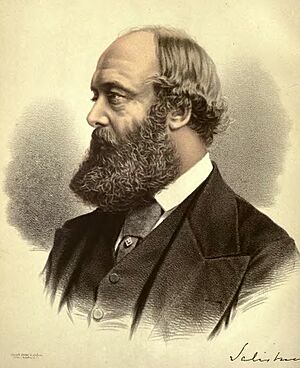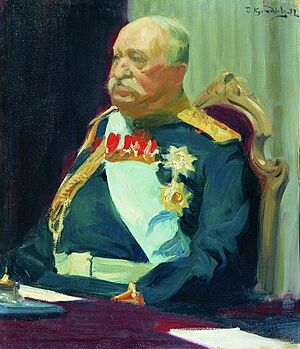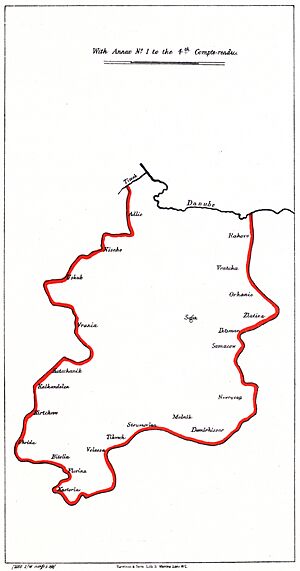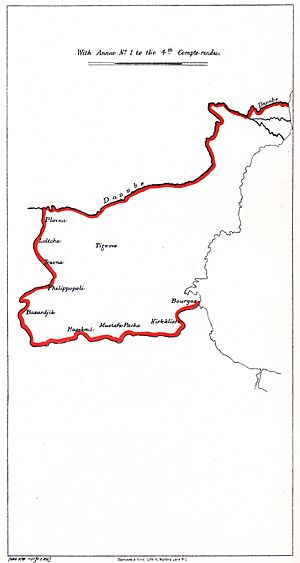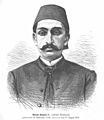Constantinople Conference facts for kids
The 1876–1877 Constantinople Conference was a big meeting held in Istanbul (which was then called Constantinople). It took place from December 23, 1876, to January 20, 1877. The meeting involved the most powerful countries of that time, known as the Great Powers. These included Britain, Russia, France, Germany, Austria-Hungary, and Italy.
The main reason for this conference was to discuss serious problems in the Ottoman Empire. There had been rebellions, especially in Herzegovina starting in 1875 and a big uprising in Bulgaria in April 1876. The Great Powers wanted to agree on a plan for political changes in both Bosnia and the parts of the Ottoman Empire where many Bulgarian people lived.
Contents
Who Was There?
The main countries and their representatives at the conference were:
- United Kingdom: Lord Salisbury and Sir Henry Elliot.
- Russian Empire: Count Nikolay Ignatyev.
- France: Count Jean-Baptiste de Chaudordy and Count François de Bourgoing.
- German Empire: Baron Karl von Werther.
- Austria-Hungary: Baron Heinrich von Calice and Count Ferenc Zichy.
- Italy: Count Luigi Corti.
Some of these people, like Lord Salisbury, Count de Chaudordy, and Baron von Calice, were special representatives just for this conference. Others, like Count Ignatyev and Sir Henry Elliot, were already their country's ambassadors in Constantinople.
Even the US Consul General in Constantinople, Eugene Schuyler, helped write the conference decisions.
The Ottoman Empire was represented by:
- Mithat Pasha, Saffet Pasha, and Edhem Pasha.
Mithat Pasha was the Grand Vizier (like a Prime Minister) of Turkey. Although the Turkish representatives attended the main meetings, they were not part of the earlier private discussions where the Great Powers worked out their plans.
Lord Salisbury from Britain and Count Ignatyev from Russia were very important in the discussions. Ignatyev tried to convince Britain that Russia's goal was to protect Orthodox Slavs, not to take over important areas like the Bosporus strait and Constantinople. Britain's Prime Minister, Disraeli, worried that Russia might threaten Britain's important trade routes to British India through the Mediterranean Sea. Lord Salisbury saw the conference as a chance to make a deal with Russia about their disagreements over land in Central Asia.
What Was Decided?
For Bosnia
The conference planned to create a self-governing area (an autonomous province) that would include Bosnia and most of Herzegovina. A southern part of Herzegovina was to be given to Montenegro.
For Bulgaria
The Great Powers agreed that Bulgaria should have a lot of self-rule. This would happen by creating two new Ottoman provinces just for Bulgarians:
- An Eastern province, with its capital in Tarnovo.
- A Western province, with its capital in Sofia.
The conference decided that these new Bulgarian areas would cover a large region. This included lands stretching from the Danube Delta in the northeast to Kastoria in the southwest, and from Kirklareli and Edirne in the southeast to Niš in the northwest.
These areas were to be included in the two new self-governing Bulgarian provinces:
- The Eastern Bulgarian province would include regions like Tarnovo, Ruse, Varna, Sliven, and parts of Plovdiv and Edirne.
- The Western Bulgarian province would include regions like Sofia, Vidin, Niš, Skopje, Bitola, and parts of Serres and Strumica.
The Great Powers also worked out many details for these new provinces. This included how their government would work, their laws, how they would be run, their defense, police, and even their taxes. They also planned for international supervision to make sure things ran smoothly.
What Happened Next?
The decisions made by the six Great Powers were officially given to the Ottoman Government on December 23, 1876. On that very same day, the Ottoman Sultan Abdul Hamid II approved a new Ottoman Constitution. The Turkish representatives suggested that this new constitution made the conference's plans unnecessary.
However, the Great Powers disagreed. During later meetings, Turkey offered its own ideas for reforms, but these were rejected by the Great Powers. Attempts to find a compromise failed. Finally, on January 18, 1877, the Grand Vizier Mithat Pasha announced that Turkey completely refused to accept the conference's decisions.
Legacy
Because the Ottoman Government refused to follow the conference's decisions, it led to the Russo-Turkish War in 1877–1878. Unlike the earlier Crimean War (1853–1856), Turkey did not get support from Western countries this time.
A place in Antarctica called Tsarigrad Peak (in Imeon Range on Smith Island) is named after the conference. 'Tsarigrad' is an old Bulgarian name for Constantinople.
Related pages
- R.W. Seton-Watson. Disraeli, Gladstone and the Eastern Question: A Study in Diplomacy and Party Politics. New York: W.W. Norton & Co., 1972. p. 108. ISBN: 9780393005943
- George Washburn. Fifty Years in Constantinople and Recollections of Robert College. Boston and New York: Houghton Mifflin, 1909. p. 115–119. ISBN: 9781406705300
Images for kids
See also
 In Spanish: Conferencia de Constantinopla para niños
In Spanish: Conferencia de Constantinopla para niños


